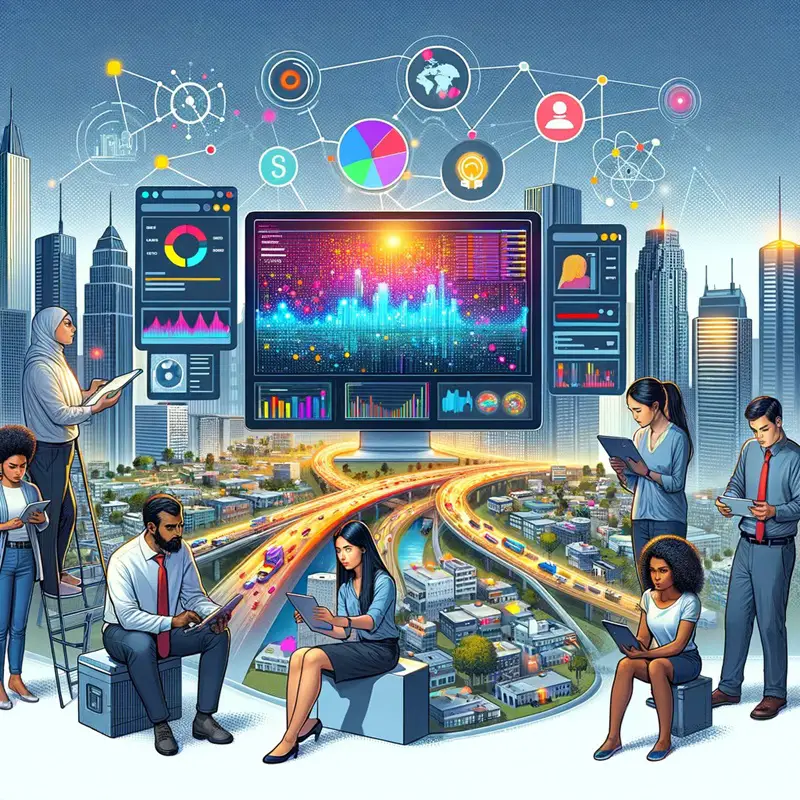Data science, an interdisciplinary field that uses scientific methods, processes, algorithms, and systems to extract knowledge and insights from structured and unstructured data, has emerged as a pivotal tool in the realm of urban planning. Urban planning, traditionally concerned with the development and design of land use and the built environment in urban spaces, now increasingly relies on the power of data science to create smarter, more efficient, and more livable cities. The introduction of data science into urban planning marks a transformative shift in how planners approach city development, from reliance on historical trends and educated guesses to data-driven decision-making.
In an era where urban areas are rapidly expanding and facing multifaceted challenges related to sustainability, resource management, and quality of life, the integration of data science offers profound benefits. It enables urban planners to analyze large volumes of data from various sources – including traffic patterns, utility usage, demographic shifts, and environmental data – to make informed decisions. This data-centric approach facilitates more accurate predictions about urban growth, helps in optimizing resource allocation, and ensures that planning strategies are adaptable to changing urban dynamics.
Furthermore, data science in urban planning plays a crucial role in engaging with the public and enhancing transparency. By leveraging data visualization tools and interactive platforms, planners can present complex urban data in a more accessible manner, fostering greater public understanding and participation in the urban planning process.

Here are 10 applications by which data science can help urban planners.
-
Predictive Modeling: Data science techniques can be used to develop predictive models that help urban planners anticipate future trends and make informed decisions. For example, by analyzing historical data on population growth, traffic patterns, and environmental factors, planners can forecast future population densities and plan accordingly for housing, transportation, and infrastructure development.
- Smart City Planning: Data science enables the collection and analysis of real-time data from various sources, such as sensors, social media, and mobile devices. This data can be used to optimize urban services, such as traffic management, waste management, energy consumption, and public safety. By leveraging data-driven insights, planners can design more efficient and sustainable cities.
- Urban Mobility Optimization: Data science can assist in optimizing transportation systems within cities. By analyzing data on commuting patterns, public transport usage, and traffic congestion, planners can identify bottlenecks and design strategies to improve urban mobility. This may include optimizing public transport routes, implementing intelligent traffic signal systems, or promoting alternative modes of transportation like cycling and walking.
- Land Use Planning: Data science techniques can aid in land use planning by analyzing various data sources, such as satellite imagery, demographic data, and economic indicators. By utilizing machine learning algorithms, planners can identify patterns and correlations to determine the most suitable locations for infrastructure development, commercial zones, green spaces, and residential areas.
- Social Equity Analysis: Data science can help address social equity concerns in urban planning. By analyzing demographic data and socio-economic indicators, planners can identify areas with high levels of inequality and devise strategies to promote inclusivity and access to essential services. This may involve identifying areas with limited access to healthcare, education, or public amenities and allocating resources accordingly.
- Environmental Impact Assessment: Data science can be used to assess the environmental impact of urban development projects. By analyzing data on air quality, water resources, biodiversity, and land use, planners can evaluate the potential environmental consequences of proposed projects. This information helps in making informed decisions to minimize negative impacts and promote sustainability.
- Emergency Response Planning: Data science can play a crucial role in emergency response planning by analyzing real-time data during crises or natural disasters. By integrating data from various sources, such as social media, emergency calls, and sensors, planners can gain insights into the affected areas, prioritize response efforts, and allocate resources effectively.
- Public Opinion Analysis: Data science techniques, such as sentiment analysis and social network analysis, can be used to analyze public opinions and attitudes towards urban planning projects. By mining data from social media platforms and online forums, planners can understand public sentiment, identify concerns, and incorporate community feedback into decision-making processes.
- Urban Heat Island Mitigation: Data science can assist in mitigating the urban heat island effect, where urban areas experience higher temperatures compared to surrounding rural areas. By analyzing data on land cover, building density, and weather patterns, planners can identify areas prone to heat island effects and implement strategies such as green infrastructure, cool roofs, and tree planting to reduce urban temperatures.
-
Tourism Planning: Data science techniques can be used to analyze tourist behavior and preferences, helping planners make informed decisions related to tourism development. By analyzing data on tourist footfall, spending patterns, and satisfaction levels, planners can identify popular attractions, improve visitor experiences, and allocate resources effectively to support sustainable tourism development.
In summary, the incorporation of data science into urban planning is not just an enhancement of traditional methods, but a necessary evolution. As cities continue to grow and face new challenges, the use of data science in urban planning will be crucial in creating sustainable, efficient, and livable urban environments for future generations.